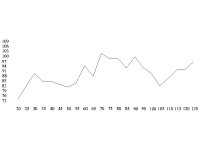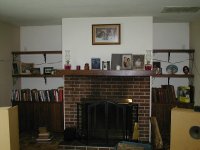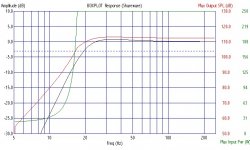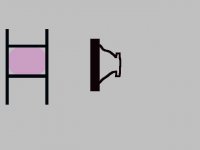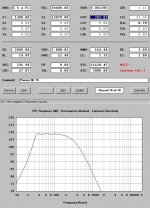loads of correction values on the web, here's one;
http://www.users.bigpond.com/bcolliso/SPL-corrections.htm
Rob.
http://www.users.bigpond.com/bcolliso/SPL-corrections.htm
Rob.
Good grief!
That places my horn in an entirely different light. Guess I've got some graphing to do or is that "redo". DoDo?
Guess I've got some graphing to do or is that "redo". DoDo?
John
That places my horn in an entirely different light.
 Guess I've got some graphing to do or is that "redo". DoDo?
Guess I've got some graphing to do or is that "redo". DoDo?John
I should have mentioned that the data in the above graph was taken at 18 feet with 1 watt imput into the horn.
John
ps: are we to assume that all the other frequencies in the radio shack spl meter are correct? Or, are we supposed to create an spl graph and superimpose it over our horn measurements?
John
ps: are we to assume that all the other frequencies in the radio shack spl meter are correct? Or, are we supposed to create an spl graph and superimpose it over our horn measurements?
Well, I broke down a ordered a microphone for my DEQ2496. Does anyone know how accurate Behringer products are? At any rate, the RTA will be on line soon. It's been years since I've tested the horn. It'll be interesting to see what's going on.
When the microphone arrives, I'll attempt to EQ the horn flat to 30hz. Seems to me the distortion sounded intolerable at 30, but we'll see.
John
When the microphone arrives, I'll attempt to EQ the horn flat to 30hz. Seems to me the distortion sounded intolerable at 30, but we'll see.
John
John,
I use an ecm8000 with trueRTA software (full version - 1/24 octave version)
http://www.trueaudio.com/rta_abt1.htm
I have a deq2496 but have never used the rta on it. Think its 1/6 octave resolution? Should give you an idea of response but I'd want at least 1/12 octave.
The ecm8000 is fairly flat in the low octaves. trueRTA has a calibration file for that mic which helps, assuming all ecm8000's are fairly close in response.
Will be interesting to see your measurements when you get the eq'ing done. Are you going to put the 18" JBL back on ? - Had the best 30Hz spl.
Rob.
I use an ecm8000 with trueRTA software (full version - 1/24 octave version)
http://www.trueaudio.com/rta_abt1.htm
I have a deq2496 but have never used the rta on it. Think its 1/6 octave resolution? Should give you an idea of response but I'd want at least 1/12 octave.
The ecm8000 is fairly flat in the low octaves. trueRTA has a calibration file for that mic which helps, assuming all ecm8000's are fairly close in response.
Will be interesting to see your measurements when you get the eq'ing done. Are you going to put the 18" JBL back on ? - Had the best 30Hz spl.
Rob.
Hi Rob, I'll be picking your brain as time goes on. It's reassuring to know someone else is using the DEQ2496. The mic won't be here until next week. Experimenting begins in earnest, then.
Just for kick, I eq'd the bass channel's dsp-30 to 30hz with a 4th LR hi pass at 20hz. I added 10db gain with a Q of 1. This is QSC and I don't know if the Q terms cross with the Behringer unit.
Oddly enough, the little Pro Kappa 10 goes very low and manages to keep the midrange sounding sweet. This driver is becoming my newest love. It doesn't hit with a bang like the JBL 2240 did down low, but then the distortion is minimal as well. Neat stuff.
I'll be out of town till Tuesday of next week. Going to Canada to see a friend.
John
Just for kick, I eq'd the bass channel's dsp-30 to 30hz with a 4th LR hi pass at 20hz. I added 10db gain with a Q of 1. This is QSC and I don't know if the Q terms cross with the Behringer unit.
Oddly enough, the little Pro Kappa 10 goes very low and manages to keep the midrange sounding sweet. This driver is becoming my newest love. It doesn't hit with a bang like the JBL 2240 did down low, but then the distortion is minimal as well. Neat stuff.
I'll be out of town till Tuesday of next week. Going to Canada to see a friend.
John
I use Ultracurve DEQ2496 as well. I use mine full range. My main intention with it was for the bass, but I have found the most noticeable improvement is in the midrange and treble. When I switch from everything off to everything on, I find the two most noticeable changes are that the image becomes wider (yes I played with stereo width) and the tonal balance much more natural. The bass also comes into line, and if the integration isn't quite right with the subs, then at least the frequency response is fixed. I also use the delay function, which is possible since I have my subs running off the auxiliary output, which can have a different delay to the mains. The mains should not be used on this output, however, since the quality is compromised so I have heard. I hope to also get Ultradrive.
From the manual:
From the manual:
Ultra high resolution 61 band real-time FFT analyser ...
Wow a lot of great discussion here. I have been rather busy of late so haven't been posting much. I suppose that I see a couple of basic approaches that might work.
1. If I get to build the house to suit I put in a large listening room with a lot of space provided to build a full wall sized straight horn in the back wall. By placing the mains in front of the listening possition by the same distance as the length of the horn we have solved the delay issue without any digital mucking about.
2. It occured to me that most of the enjoyment from the organ is available without even using the 32' stops. The 16' stops give plenty of power and body. My current sub does not go below 30 Hz and still gives somewhat credible results. So given that most of the impact is in the second through fourth octaves I could use horn subs that go down to only 30 or 40 Hz and suppliment below that with direct radiators to catch the 32' ers. Now it will all fit nicely in my existing space.
I have attached a picture of the front wall of my listening space. By removing the cabinets and shelves I have room for a 2.75'x8'(x2' deep) horn on each side with a 14" sliver beside the left one (that recess is larger than the one on the right) of 17 ft^3 capacity for the direct radiators. That sliver can hold four 12" titanic subs tuned EBS to 15Hz.
This should give me all the bass output I need even if I decided to get into HT an put an LCD TV on the mantel. The sensible thing to do first I suppose is build the direct radiators since they can cover all the way up to 80Hz by themselves. The horns could be added later and the crossover to the sub-sub woofers adjusted accordingly.
OK. That is a lot of wood and paper but we are talking ultimate here. 😉
mike
1. If I get to build the house to suit I put in a large listening room with a lot of space provided to build a full wall sized straight horn in the back wall. By placing the mains in front of the listening possition by the same distance as the length of the horn we have solved the delay issue without any digital mucking about.
2. It occured to me that most of the enjoyment from the organ is available without even using the 32' stops. The 16' stops give plenty of power and body. My current sub does not go below 30 Hz and still gives somewhat credible results. So given that most of the impact is in the second through fourth octaves I could use horn subs that go down to only 30 or 40 Hz and suppliment below that with direct radiators to catch the 32' ers. Now it will all fit nicely in my existing space.
I have attached a picture of the front wall of my listening space. By removing the cabinets and shelves I have room for a 2.75'x8'(x2' deep) horn on each side with a 14" sliver beside the left one (that recess is larger than the one on the right) of 17 ft^3 capacity for the direct radiators. That sliver can hold four 12" titanic subs tuned EBS to 15Hz.
This should give me all the bass output I need even if I decided to get into HT an put an LCD TV on the mantel. The sensible thing to do first I suppose is build the direct radiators since they can cover all the way up to 80Hz by themselves. The horns could be added later and the crossover to the sub-sub woofers adjusted accordingly.
OK. That is a lot of wood and paper but we are talking ultimate here. 😉
mike
Attachments
P.S. It has been mentioned that you can stack horns to extend the bottom end. I don't understand how this works. How can the mouth of one horn load the driver of the other horn? Each driver is feeding a different air column. Do the two air columns couple some how?
mike
mike
Stacking just means that you put horns so that their mouths join up and give you a bigger mouth. If you are designing for this, you might do it like this:
stack of 2
1. simulate with two drivers in hornresp in one horn
2. build 2 horns, keep the horn length the same as that one horn, but the throat will be half, the mouth will be half and the cross sectional area of each will be half at each point
So lets say you have two 12" drivers, axial length is 2.7m, throat is 500 cm2 and mouth is 12000 cm2. Each cab will still have 2.7m length, but throat will be 250 cm2 (compression ratio of 2) and mouth will be 6000 cm2.
stack of 2
1. simulate with two drivers in hornresp in one horn
2. build 2 horns, keep the horn length the same as that one horn, but the throat will be half, the mouth will be half and the cross sectional area of each will be half at each point
So lets say you have two 12" drivers, axial length is 2.7m, throat is 500 cm2 and mouth is 12000 cm2. Each cab will still have 2.7m length, but throat will be 250 cm2 (compression ratio of 2) and mouth will be 6000 cm2.
FYI
I pulled the pro-kappa 10 and replaced it with a JBL 2240. As you may recall, the left channel has a pair of 2240s in a 12 cubic foot, sealed enclosure. Both channels are eq'd the same. As mentioned in my last post: 10db gain at 30hz, Q of 1, with a 30hz high-pass filter in the mix.
The verdict:
The horn doesn't go nearly as low in frequency as the sealed enclosure. It plays louder on half the wattage, but doesn't go as deep. I didn't realize this would happen. So, there's no free lunch with a horn. It is what it is... I don't have new SPL specs to compare against the old graph. Someday, perhaps.
The JBL 2240 sounds nice, powerful, but not nearly as sweet in the mid-range as the pro-kappa 10.
I've also learned how subjective music (bass in this instance) is to each individuals ears. My wife doesn't like the pro-kappa 10. It's too weak, she says. B.S., says I. Humph... Come to think of it, I hear bass much better than she, and with treble, it's the exact opposite. I want less bass, she wants more. I want more treble, she wants less. Typical man/woman stuff...
John
I pulled the pro-kappa 10 and replaced it with a JBL 2240. As you may recall, the left channel has a pair of 2240s in a 12 cubic foot, sealed enclosure. Both channels are eq'd the same. As mentioned in my last post: 10db gain at 30hz, Q of 1, with a 30hz high-pass filter in the mix.
The verdict:
The horn doesn't go nearly as low in frequency as the sealed enclosure. It plays louder on half the wattage, but doesn't go as deep. I didn't realize this would happen. So, there's no free lunch with a horn. It is what it is... I don't have new SPL specs to compare against the old graph. Someday, perhaps.
The JBL 2240 sounds nice, powerful, but not nearly as sweet in the mid-range as the pro-kappa 10.
I've also learned how subjective music (bass in this instance) is to each individuals ears. My wife doesn't like the pro-kappa 10. It's too weak, she says. B.S., says I. Humph... Come to think of it, I hear bass much better than she, and with treble, it's the exact opposite. I want less bass, she wants more. I want more treble, she wants less. Typical man/woman stuff...
John
Mashaffer, hi.
Is the picture you posted your home? Are your building a new home? What's behind the walls to the L/R of the mantle?
You've got some brain-work going. I like your enthusiasm.
Keep in mind that horns are more efficient than direct drivers. If you horn load the bass, then the upper frequencies should either be VERY efficient drivers, or else horn loaded. Otherwise, you will be turning down the bass horn's volume control in order to hear the treble. Once you do that, what's the purpose of having a bass horn? Also, if the direct radiators are operating in the same frequency band as the horn, you may have time alignment anomalies. This isn't necessarily horrible sounding, it's just that the reproduction will not be true to the source. You'll get a fatter bass note, which can sound slurred if the rhythm has a rapid tempo.
From a time alignment standpoint, I like the idea of a rear subhorn--as long as the mouth is huge. If you use 1/8 space calcs for the mouth, then the bass wave won't form until it hits the other side of the room. Use 50hz horns in your front mains. These are manageable size-wise.
Keep the dream alive!
John🙂
Is the picture you posted your home? Are your building a new home? What's behind the walls to the L/R of the mantle?
You've got some brain-work going. I like your enthusiasm.
Keep in mind that horns are more efficient than direct drivers. If you horn load the bass, then the upper frequencies should either be VERY efficient drivers, or else horn loaded. Otherwise, you will be turning down the bass horn's volume control in order to hear the treble. Once you do that, what's the purpose of having a bass horn? Also, if the direct radiators are operating in the same frequency band as the horn, you may have time alignment anomalies. This isn't necessarily horrible sounding, it's just that the reproduction will not be true to the source. You'll get a fatter bass note, which can sound slurred if the rhythm has a rapid tempo.
From a time alignment standpoint, I like the idea of a rear subhorn--as long as the mouth is huge. If you use 1/8 space calcs for the mouth, then the bass wave won't form until it hits the other side of the room. Use 50hz horns in your front mains. These are manageable size-wise.
Keep the dream alive!
John🙂
Yes that is my current listening room. The two stall garage is behind those nooks  Thus my original idea of a straight horn in the garage. Alas I think we have determined that the mouth area available is not enough.
Thus my original idea of a straight horn in the garage. Alas I think we have determined that the mouth area available is not enough.
I am not building a new home... yet. The OBs you see in the picture are the main speakers that I am using now. Recycled 8" drivers from an old Philco SS console with RS dome tweeters connected via 4uF caps. It gets pretty uncomfortable in there at 1 watt so they are pretty efficient.
I am using a cheapo AR 8" "subwoofer" to cover 30-80Hz range. Considering the micro bucks spent it is doing pretty well.
My reason for wanting horn bass is for maximum impact on tympanni and bass drum along with minimum distortion for string bass and similar intruments. I like your suggestion of 50Hz horns as this will pretty well cover those instruments as well as even the best bass voices. Then I can catch the 16-50Hz range with conventional ported sub or bandpass. First step is probably the conventional sub which I could even house in that cabinet on the left side (about 9.5 - 10 ft^3). This new PE sub is very tempting. DCS380-4 15" sub
Even in the slightly smaller than optimum volume of that cabinet on the left (9.7 v.s. ideal of 13 cubic feet) they model very nicely (see attached). Of course if I do Isobarik I could go subsonic in the same enclosure. 😉
Of course with the garage behind I could build enclosures of any desired size behind the wall and tune to my heart's content.
mike
 Thus my original idea of a straight horn in the garage. Alas I think we have determined that the mouth area available is not enough.
Thus my original idea of a straight horn in the garage. Alas I think we have determined that the mouth area available is not enough.I am not building a new home... yet. The OBs you see in the picture are the main speakers that I am using now. Recycled 8" drivers from an old Philco SS console with RS dome tweeters connected via 4uF caps. It gets pretty uncomfortable in there at 1 watt so they are pretty efficient.
I am using a cheapo AR 8" "subwoofer" to cover 30-80Hz range. Considering the micro bucks spent it is doing pretty well.
My reason for wanting horn bass is for maximum impact on tympanni and bass drum along with minimum distortion for string bass and similar intruments. I like your suggestion of 50Hz horns as this will pretty well cover those instruments as well as even the best bass voices. Then I can catch the 16-50Hz range with conventional ported sub or bandpass. First step is probably the conventional sub which I could even house in that cabinet on the left side (about 9.5 - 10 ft^3). This new PE sub is very tempting. DCS380-4 15" sub
Even in the slightly smaller than optimum volume of that cabinet on the left (9.7 v.s. ideal of 13 cubic feet) they model very nicely (see attached). Of course if I do Isobarik I could go subsonic in the same enclosure. 😉
Of course with the garage behind I could build enclosures of any desired size behind the wall and tune to my heart's content.
mike
Attachments
BTW when firing a 15" through the wall (16" centers) is there any reason why I couldn't put horizontal sections of 2x4 between adjacent joists to make a box and mount the speaker to the back of a piece of MDF fixed over the back of that frame like this (pink is the cone viewed from the front). So there would be a box about 3.5" thick between the cone and the grill. It would seem that almost none of the radiating area would be covered by the 2x4s. However would there be any loading or resonance issues with that space? If so could it be flared to prevent problems?
mike
mike
Attachments
mashaffer,
You can construct a pair of excellent sounding straight horns in those recesses on the L/R of the mantle. With boundary effects, you can certainly get down to 40hz.
The mouth on my horn is only 28" x 56"; you can see on the graph, in my prior post, that it has decent performance down to 55hz. The mouth on your horn would be considerably larger than mine. You may only be parking one car in your garage though! If you can talk the misses into accepting your adventure, then construct at least one horn and give it a listen. If you love the sound, build a mate on the other side. I place my subs behind my listening area. That way they don't work as hard. If you balance out the volume, they blend with the front horns beautifully.
Last night I enjoyed my music more than I have in years. The JBL 2240, in my horn, does drums like nobody's business! It may not hit as low as the sealed, dual 2240 cab in the left channel, but when the volume is up, it's the drums from the horn that I hear, not the sealed enclosure. The T/L subs kick out some serious lows to compliment the horn. Massive entertainment!
John🙂
You can construct a pair of excellent sounding straight horns in those recesses on the L/R of the mantle. With boundary effects, you can certainly get down to 40hz.
The mouth on my horn is only 28" x 56"; you can see on the graph, in my prior post, that it has decent performance down to 55hz. The mouth on your horn would be considerably larger than mine. You may only be parking one car in your garage though! If you can talk the misses into accepting your adventure, then construct at least one horn and give it a listen. If you love the sound, build a mate on the other side. I place my subs behind my listening area. That way they don't work as hard. If you balance out the volume, they blend with the front horns beautifully.
Last night I enjoyed my music more than I have in years. The JBL 2240, in my horn, does drums like nobody's business! It may not hit as low as the sealed, dual 2240 cab in the left channel, but when the volume is up, it's the drums from the horn that I hear, not the sealed enclosure. The T/L subs kick out some serious lows to compliment the horn. Massive entertainment!
John🙂
One more change,
Heck, who am I trying to kid? I'll be making changes forever. That's who I am.
Anyway, I pulled the 2240 from the bass horn this morning and replaced it with a Pro Kappa 12" bass unit. This fellow has the smooth character of it's little 10" brother, but hits harder in the lower register. This particular horn was designed for a 12 or 15 inch low Q driver, and the results are outstanding when kept in this area. At 1.75 cubic feet (gross, minus speaker), the speaker enclosure is fairly small and therefore well suited to the lower Q speaker. The throat is 50 sq. in. and suitable for a driver with 100 sq. in. cone area. The 12" driver has less surface area than that, but the horn is so efficient that the sacrifice in compression is worth the trade-off for explosive transients. I'm happier with smoother transients vs. getting slapped on my rear.
Later folks,
John🙂
Heck, who am I trying to kid? I'll be making changes forever. That's who I am.
Anyway, I pulled the 2240 from the bass horn this morning and replaced it with a Pro Kappa 12" bass unit. This fellow has the smooth character of it's little 10" brother, but hits harder in the lower register. This particular horn was designed for a 12 or 15 inch low Q driver, and the results are outstanding when kept in this area. At 1.75 cubic feet (gross, minus speaker), the speaker enclosure is fairly small and therefore well suited to the lower Q speaker. The throat is 50 sq. in. and suitable for a driver with 100 sq. in. cone area. The 12" driver has less surface area than that, but the horn is so efficient that the sacrifice in compression is worth the trade-off for explosive transients. I'm happier with smoother transients vs. getting slapped on my rear.
Later folks,
John🙂
Maybe something like this firing into the corner behind and to the side of my chair. A seven foot long horn and my mains about 5-6 feet in front should be pretty decent WRT delay right? Drivers used was a pair of pioneer 15" MI speakers as being representative of type.
How about vertical horn firing down into the floor? Would that ruin the transient repsonse?
Mouth is about 13-14 sq feet if I did the artithmatic right.
mike
How about vertical horn firing down into the floor? Would that ruin the transient repsonse?
Mouth is about 13-14 sq feet if I did the artithmatic right.
mike
Attachments
Firing to the floor would mean no corner loading, hence now quarter space loading. It would have twice the mouth size for the same result, and be much bigger to get any improvement. I would say always aim for corner loading, unless the mouth is the size of one of the walls, in which case you are effectively sitting in the horn's mouth and then you have better than eigth pi space since the expansion is more constrained.
more stuff...
How large is your room? Is that pic taken from the back wall? The horn you're describing is quite small for a sub. Or, has the plan taken a twist? Ha, in my case it's a certainty.
Stuff I'm discovering:
I hooked up my Behringer DEQ2496 today--got the xxx8000 mic running too. I've never owned an RTA... they are so cool! I also downloaded from iTunes a pink noise track and all the test tones from 20 to 99hz. I didn't have time to really get into the test, but the weekend's coming. Right? What I did see in the 20 to 30 hz range was amazing. Remember the front bass is EQ'd in identical fashion, and there's twin 18" 2240s on the left, single pro kappa 12 horn loaded on the right. I turned the balanced knob L to R. Under 30hz, the 2240s ran consistently 10db louder than the horn. Things evened out at 40hz... I think. The db scale fluctuates to accommodate the SPL level, and it's easy to overlook the db scale on the left while staring at the bar graph doing its thing. The bar graph stays pretty much the same, but the scale changes. I'll get this baby straight and bring home some decent data ASAP.
I'm thinking that if you can afford the drivers and the wattage, sealed enclosures with a Qtc of 0.5 and some EQ can best a horn for all round performance. If you're on a budget, or require high SPL above 40hz horns are very cool. This is home audio I'm talking about, not Pro, DJ, or Raves.
John🙂
edit: Oh, I'm using the DEQ2496 to boost the subwoofers 10db at 20hz using the parametric. It's unnerving to hear the bass stay flat down to 20. BTW, I turned off the subs when performing the test tones on the mains.
How large is your room? Is that pic taken from the back wall? The horn you're describing is quite small for a sub. Or, has the plan taken a twist? Ha, in my case it's a certainty.
Stuff I'm discovering:
I hooked up my Behringer DEQ2496 today--got the xxx8000 mic running too. I've never owned an RTA... they are so cool! I also downloaded from iTunes a pink noise track and all the test tones from 20 to 99hz. I didn't have time to really get into the test, but the weekend's coming. Right? What I did see in the 20 to 30 hz range was amazing. Remember the front bass is EQ'd in identical fashion, and there's twin 18" 2240s on the left, single pro kappa 12 horn loaded on the right. I turned the balanced knob L to R. Under 30hz, the 2240s ran consistently 10db louder than the horn. Things evened out at 40hz... I think. The db scale fluctuates to accommodate the SPL level, and it's easy to overlook the db scale on the left while staring at the bar graph doing its thing. The bar graph stays pretty much the same, but the scale changes. I'll get this baby straight and bring home some decent data ASAP.
I'm thinking that if you can afford the drivers and the wattage, sealed enclosures with a Qtc of 0.5 and some EQ can best a horn for all round performance. If you're on a budget, or require high SPL above 40hz horns are very cool. This is home audio I'm talking about, not Pro, DJ, or Raves.
John🙂
edit: Oh, I'm using the DEQ2496 to boost the subwoofers 10db at 20hz using the parametric. It's unnerving to hear the bass stay flat down to 20. BTW, I turned off the subs when performing the test tones on the mains.
- Status
- Not open for further replies.
- Home
- Loudspeakers
- Subwoofers
- My ideal Sub plans
